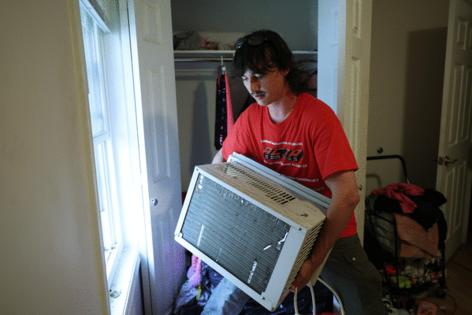Free air conditioner programs help amid life-threatening heat
Published in News & Features
With heat advisories blanketing the eastern half of the U.S., air conditioners are once again working over time as essential resources to keep millions cool. But they’re unevenly distributed: Many poor households are unable to afford them.
To reduce the gap between the air conditioning haves and have nots, a growing number of programs are giving them out for free with waiting lists numbering in the thousands. And they view them as means to protect public health and reduce poverty.
Heat-related deaths have doubled over the last quarter century, and more people will be at risk as the planet warms. Temperature increases are correlated with higher disease risk and mortality rates. Extreme heat can reduce productivity, impact children’s cognitive development and lower overall well-being.
“Each individual heat-related death is preventable,” said Kai Chen, a researcher of environmental health at Yale University, “and in the past 20 years, air conditioning use has drastically reduced heat-related mortality.”
He added that without ACs, the amount of heat-related deaths in the US would likely double, especially for older adults.
There are 14 million households without air conditioning in the U.S., but lack of access is more acute in some communities. In New York, 10% of households don’t have AC, but that percentage doubles in many Black, Latino and low-income neighborhoods. Over 500 people die from heat in New York City each summer, mostly at home with a broken or underpowered air conditioner, according to the city’s most recent report on heat mortality. The top reason for the lack of cooling: cost.
The state’s Home Energy Assistance Program (HEAP) provides ACs to low-income households with members over 65 or under 6, and Gov. Kathy Hochul launched a program in June that makes units available to any low-income adult with asthma, which is exacerbated by heat.
The new program, which distributes the ACs through enrollment in the state’s Essentials Healthcare Plan, focuses on ages that HEAP does not cover.
“We think this is really important as extreme weather events are happening more and more and with a lower-income population with health needs, this is absolutely a meaningful way we can help them manage their health,” said Danielle Holahan, executive director at New York State of Health, the state’s marketplace for affordable health insurance, which administers the program.
But the program and others like it face challenges due to funding cuts. Federal money for many state-level heating and cooling relief programs is in peril, and energy-efficiency tax credits, which help households afford better cooling appliances, have been cut as part of President Donald Trump’s recently signed tax law.
The bedrock of New York’s program, the Essentials Healthcare Plan, was implemented under the Affordable Care Act. According to Holahan, the program has funding for the next five years, but cuts to the ACA in the new law could remove eligibility for about 730,000 enrollees, especially lawfully present immigrants.
Local, nongovernmental groups run similar programs and have found strong demand. In Cincinnati, which will see a run of extreme heat break by the end of the week, there's a waiting list of more than 2,700 people for a program that gives out free air conditioners.
The program, run by the anti-homelessness charity St. Vincent de Paul, provides ACs to anyone 65 and older or with a medical need. Their waiting list grew by 700 in the last few weeks alone.
While St. Vincent de Paul Cincinnati’s program initially gave out fans, that felt like a “band-aid” for a persistent problem, said Kaytlynd Leinhart, who leads the organization’s development and marketing. The group switched to ACs in 2019. It is funded by local donors, businesses and foundations.
Leinhart said nonprofits carry more responsibility after pandemic-era support tapered off. She emphasized how cooling can be a stepping stone out of a crisis by providing something as simple as good night’s sleep.
“If you're a single mom on one income, imagine that that's how you're starting your day every day, with your baby having not slept, you've not slept, you've been severely uncomfortable all night,” she said.
Providing a free AC can help individuals cope with heat stress and better attend to pressing challenges.
Demand is especially high this year. The Cincinnati program gave out over 700 ACs in both 2023 and 2024 while in 2022, it provided 980 units. This year, it expects to exceed 1,000 units.
However, providing that many will cost $110,000, and the group only has $75,000 in funding this year. With such a long waitlist, many won’t receive relief.
Climate change is making summers hotter in New York and Cincinnati, places that already regularly experience temperatures above 90F (32C). Traditionally cool cities where air conditioning is less prevalent are also seeing temperatures rise. As it gets hotter, though, free home cooling programs are becoming more common.
“Cooling is going from being a luxury or a ‘nice to have’ in many places to being essential for health and safety,” said Laila Atalla, a building decarbonization expert at clean energy nonprofit RMI.
In the wake of a 2021 heat dome that killed hundreds across the US Pacific Northwest and Canada, the city of Portland, Oregon, formed Cooling Portland with the nonprofit Earth Advantage to install energy-efficient heat pumps in households at high risk of heat-related illness.
Using heat pumps is the ideal solution because of their reliability, smaller environmental footprint and affordability, reducing cooling costs by about 20%, Atalla said.
In 2022, Cooling Portland set a target of installing 15,000 units by 2027, but it reached that goal earlier this summer and plans to install 5,000 units this year alone. In a city that is 70% white, the program is helping close the racial cooling disparity: Of those served, about a third are Black and 14% Hispanic or Latino.
Portland funds its work through a 1% surcharge on local billion-dollar corporations, passed via a 2018 ballot measure. The fund — which has raised $1.2 billion — can only be used for climate justice initiatives.
Amidst the Trump administration’s cuts to social welfare and climate programs, Atalla said that local governments and utilities can do more to improve cooling access using money they already have. They noted that the US spends $9 billion a year on energy efficiency programs that only 3% of households take advantage of because of complex applications, inconsistent eligibility requirements and income verification hurdles.
“There’s an equity dimension here too,” Atalla said. “Low-income households are about one-third as likely to receive an energy-efficiency incentive.”
Atalla underscored that programs that can help cover the costs of energy bills — which low-income households spend a disproportionate amount of income in — can also help make free air conditioner programs more effective. They also pointed to a Colorado bill that would prevent utilities from disconnecting power for nonpayment during extreme heat events as another means to keep people safe.
©2025 Bloomberg L.P. Visit bloomberg.com. Distributed by Tribune Content Agency, LLC.







Comments